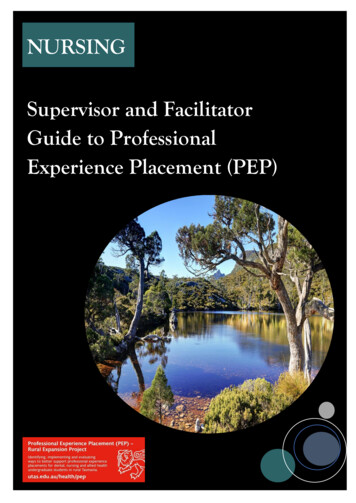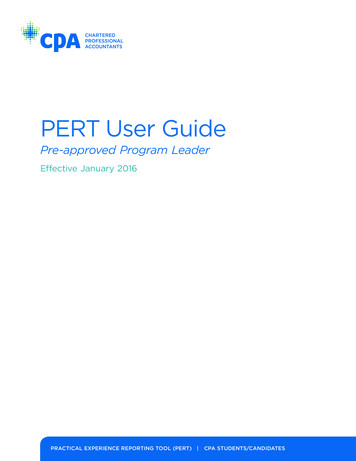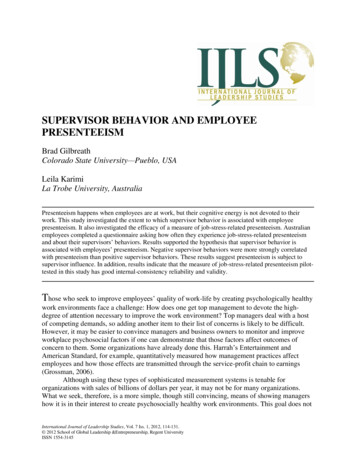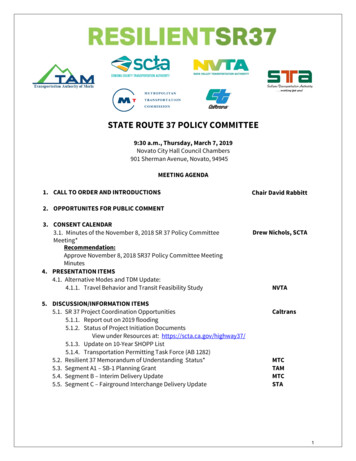
Transcription
NURSINGSupervisor and FacilitatorGuide to ProfessionalExperience Placement (PEP)1
2020School of NursingCollege of Health and MedicineUniversity of TasmaniaLocked Bag 1322Launceston TAS 7250Australia2
The University of Tasmania would like tothank you for your ongoing commitmentto supporting quality ProfessionalExperience Placement (PEP) for ourSchool of Nursing (SON) students.Your willingness to supervise andfacilitate student learning in the practiceenvironment enables the development ofa safe and skilled future healthcareworkforce.About this GuideThis resource is designed to support you in your learning and teachingrole of students undertaking the practical or (PEP) components of theirBachelor of Nursing degree. This guide is organised in two sections. Thefirst explains how PEP is structured and undertaken at the University ofTasmania. The second section provides guidance on the process ofeffective PEP supervision and facilitation to enable positive learningexperiences for students as they develop the necessary capability as abeginning-level practitioner. Across topic areas there are suggested linksfor further resources and more in-depth information.This guide is also available on the PEP nceplacement/supervisors.If you have any suggestions or additional content for the improvement ofthis guide you are welcome to provide these via email toJ.F.Cooper@utas.edu.au.This resource was written and compiled byDr Linda Jaffray (Professional Experience Placement Rural ExpansionProject) and John Cooper (Academic PEP Coordinator, School of Nursing)at the University of Tasmania.Photographic images by Darren Grattidge.3Version 1.0. For revision in February 2021
ContentsSection 1: Professional Experience Placement (PEP) at the University of Tasmania . 5About Professional Experience Placement (PEP). 6PEP in Context of the Curriculum . 7BN Course Pathways and PEP Overview . 8Key University Contacts for PEP . 10Resources and Training. 11PEP Processes . 12Scope of Practice & Supervision During PEP. 16Assessment in PEP: The PEP Workbook . 18Section 2: Effective PEP Supervision and Facilitation . 22Overview of Resources . 23Supervisor and Facilitator Approach & Key Attributes . 24Factors Underpinning High Quality PEP. 25Preparation for PEP . 26Adult Learning and Professional Socialisation . 28Student Learning Styles & Student-centred Teaching . 29Clinical Reasoning Cycle . 30Welcome and Orientation of Students . 33Supporting Student Reflection . 35Providing Constructive Feedback . 36Interprofessional Learning (IPL) . 40Navigating Challenges to Support Student Learning . 42The over-confident or shy, introverted student . 42Students who present as disinterested or disengaged. 43Uncertainty about workplace requirements . 43Student Progression . 43Tension within the supervisor / facilitator and student relationship . 44Distressed Students . 45Conflict Resolution. 46Self-care, Professional Development and Support . 49References . 504
NURSINGSection 1: Professional ExperiencePlacement (PEP) at the University ofTasmaniaAbout PEPPEP in Context of the CurriculumBN Course Pathways and PEP OverviewKey University ContactsLinks to Resources and TrainingPEP ProcessesScope of Practice, Supervisionand Assessment5
About Professional Experience Placement (PEP)Professional Experience Placement or ‘PEP’ is a structured and formal learning experience that enablesstudents to put theory into practice within a workplace setting. PEP, often referred to in nursing as ‘prac’ or‘clinical placement’, has two primary objectives. Firstly, it seeks to immerse students in healthcareenvironments to apply and consolidate newly acquired knowledge and skills. Secondly PEP aims to increasestudent understanding of the diverse roles undertaken by registered nurses and other health professionals,within the Australian healthcare system.Within PEP, students will work along-side registered nurses and other healthcare professionals, contributingdirectly to quality patient care.Professional Experience Placement (PEP) is a compulsorycomponent of the Bachelor of Nursing program, with allstudents undertaking 840 hours of PEP within a variety ofhealthcare environments and locations across theirdegree.Nursing students undertaking PEP within theundergraduate program are supernumerary.This enables students the opportunity to learnand develop in PEP through:PEP is integral to the broad experiential curriculum of theBachelor of Nursing (BN), which aims to graduate studentsas safe beginning-level registered nurses.ObservationParticipationPEP is a time for students to place into context andtransfer theoretical knowledge into real-world practicesettings.Reflection on PracticeSkill Development / ConsolidationThrough supported experiential learning, it is the role ofsupervisors and facilitators to help ‘bring theory to life’;assisting students to make meaning of the knowledgetransfer and provide opportunities for students to developand demonstrate the requisite knowledge, skills andattributes which underscore the profession of nursing.Interprofessional LearningInservice Education and SeminarsWritten Work and Critical ThinkingPEP Healthcare Environments and LocationsTo satisfy the requirements of Australian Nursing and Midwifery Accreditation Council (ANMAC) and Universitycourse requirements, students are required to complete a range of PEPs. Typically, students undertakeplacements in both rural/remote and metropolitan settings across the degree in key nursing areas such as:Acute CareAged CareCommunity NursingMental HealthPrimary Health6
PEP in Context of the CurriculumThe Bachelor of Nursing program at the University of Tasmania, contains five units of study that includePEP as a core component.Unit CodeUnit TitleDurationHoursNUR135Nursing Practice 12 weeks80NUR239Nursing Practice 23 weeks120NUR242Nursing Practice 33 weeks120NUR351Nursing Practice 46 weeks240NUR354Nursing Practice 57 weeks280Total840 **Please note: The minimum number of PEP hours required to be eligible to apply for registration as aRegistered Nurse with the Australian Health Practitioners Regulation Agency (AHPRA) is 800 hours.Within the Bachelor of Nursing, 840 hours has been allocated to each student to take into considerationtypical national and regional public holidays that occur each year over the course of the degree.Over the nursing program, the specific expectations of students and assessment tasks undertaken duringPEP are incremental. This means that each successive PEP supports the increased development andapplication of a discrete, but related set of skills, knowledge and professional behaviors.Students transition from an introductory/observational PEP in Nursing Practice 1 (NUR 135), through todemonstrating the required level of capability as a beginning-level practitioner upon completion ofNursing Practice 5 (NUR354) in accordance with regulatory, legislative and professional requirements.For a more comprehensive understanding of expected capabilities for each PEP please see thedocument ‘BN Student Developmental Indicators for PEP’ in the ‘resources for supervisors section onthe PEP website ators7
BN Course Pathways and PEP OverviewThe Bachelor of Nursing at the University of Tasmania can beundertaken through three different course offerings or pathways,available from either our Hobart, Launceston, Burnie or Sydneycampuses.Students apply for enrolment into one of the course offeringsbelow: 2-year (accelerated) program3-year (full-time) program*4-year (part-time) program*Not available in SydneyRegardless of course pathway, all students engage in 24 units ofstudy, inclusive of five PEP experiences across the program.Each academic year contains three Nursing Study Periods (NSP) oftwelve weeks duration. The number of units per study period varydepending on the course pathway chosen.The diagram on the following page provides a visual map of theunits of study of each course offering within the Bachelor ofNursing and where Professional Experience Placement (PEP) issituated within the program.For a more comprehensive document outlining each coursepathway, specific unit details, and where traditional PEPofferings will now occur, please access the nursing resourcesunder the ‘support for supervisors’ tab on the PEP enceplacement/supervisors8
BN COURSE PATHWAYS AND PEP OVERVIEWIn the BN degree, studentscan elect to undertake theaccelerated pathway of twoyears.Undertaking theBN degree,across threeyears is anotheroption forstudents.The option of a four-year (part-time) course pathway also exists.9
Key University Contacts for PEPWithin the School of Nursing, PEP is managed by the School of Nursing PEP Team in accordance withCollege of Health and Medicine requirements. Professional and academic staff, located in Tasmaniaand New South Wales (NSW), work to ensure each student is supported and has access to the relevantinformation in the lead up to, and during each PEP experience. The following information identifieskey personnel and sources of information / support for facilitators and supervisors.Fieldwork Coordinators (FWC)Fieldwork Coordinators (FWC) are the primary university contact forstudents, facilitators, and supervisors during PEP. Please see the PEPwebsite for the names and contact emails for the Fieldwork Coordinator inyour area atorsFor the duration of each PEP, Fieldwork Coordinators also carry a mobilephone to enable direct contact in the case of a critical incident oremergency. The emergency number and any additional contact details willbe provided to you in the lead up to each placement.Academic PEP CoordinatorAll elements of PEP within the School of Nursing have academic oversightprovided by the Academic Professional Experience Placement Coordinator.This role works closely with all members of the PEP team to ensure eachstudent receives a quality placement experience in accordance withprogram and unit requirements. The Academic PEP Coordinator for theSchool of Nursing is John Cooper J.F.Cooper@utas.edu.auPEP compliance, allocations, andgeneral information enquiriesTasmanian PEP Team (for TAS BN Students):Tasmania.Placements@utas.edu.auNSW PEP Team (for NSW BN Students):Sydney.Placements@utas.edu.auPEP WebsiteThe College of Health and Medicine’s PEPWebsite is another source of information,providing up to date PEP resources tosupport you in your -placementTo follow professional experience placement information:Whole of Community Facilitators (WOCFs)For supervisors of students undertaking PEP in rural and remote areas of Tasmania, as well as non-Tasmanian Health Service(THS) placements on the North West Coast, Whole of Community Facilitators are another important University contact. Therole of the Whole of Community Facilitator (WOCF) is to support rural supervisors in their learning and teaching of nursing andallied health students.To identify and contact the WOCF in your region please visit the PEP website: itatorsAdditional Avenues for Student Information and SupportStudent Accommodation and Financial Support Assistance. For information students should be advised to contactCRH.Accommodation@utas.edu.au or phone 61 3 6324 4012.Student Counselling Services. Information about student counselling services can be found on the University websitewww.utas.edu.au/students/shw/counselling.10
Resources and TrainingThe School of Nursing at UTAS provides varied learning events and workshops to supportsupervisors and facilitators in the PEP space. Keep your eye on the PEP Website for upcomingevents: atorsThis document provides an overview of PEP, as delivered through the Bachelor of NursingProgram, at the University of Tasmania. It also contains fact sheets and brief guidance on a rangeof topics related to supporting student learning in the practice environment, including commonchallenges identified by our industry partners.In addition, there is a wealth of online resources and training relevant to supervision andfacilitation of student PEP and work integrated learning. Please see the following for a place tostart:[To enter websites and resource links sity of Queensland PracticeEducation Videos (OccupationalTherapy-based resources)SUPPORTING HEALTH STUDENTSIN THE WORKPLACEwww.supportingstudents.org.au/‘Peer Coaching and Work Integrated Learning:Practice Guide For Fieldwork Supervisors’, hing-and-work-integrated-learning.pdfThe University of Queensland, OccupationalTherapy Practice Education ories-awards/practice-education-videosThe National Association of Field Experience AdministratorsInc. https://nafea.org.au/11
PEP ProcessesThe School of Nursing’s Professional Experience Placement (PEP), at theUniversity of Tasmania, must ensure the safety of students, staff, and thebroader community through completion of all mandatory legislative, regulatory,placement partner and university requirements.School of Nursing PEP is governed by the University’s Professional ExperiencePlacement Policy and a suite of process documents written and maintained bythe College of Health and Medicine to guide students and stakeholders pre,during and post PEP.Links to these documents are located under the ‘compliance’ and ‘PEP Processes’ tabs on the PEPWebsite cement.The following section provides an overview of student requirements related to compliance,professional standards, mandatory functional requirements, medication management and general PEPguidelines.Student ComplianceParticipation in PEP is conditional on nursing students completing and maintaining all mandatorycompliance requirements set out in the School of Nursing Student Compliance section on the PEPwebsite: cement/safety-in-practicerequirements. As a snapshot, these include the following items: Safety in Practice Agreement Health Assessment (if required) National Police Record Check Certificate Working with vulnerable people (children) registration Immunisation Record (infectious disease and immunisation status) Hazardous Materials Task Handling (Manual Handling) & Basic Life Support (BLS) Hand Hygiene Any specific placement partner requirements (as advised).Professional StandardsUpon enrolment into the Bachelor of Nursing degree, each student is automatically enrolled on thestudent nurse register with AHPRA. As such, students are expected to conduct themselves and practicein accordance with the registration standards, codes of professional and ethical conduct and guidelinesthat govern safe and effective nursing practice in Australia NMBAs RN Standards for Practice (2016).12
PEP ProcessesMandatory Functional RequirementsAll students are required to establish and maintain their medical, physical and psychologicalcapacity to practise safely, inclusive of:1.Reading, Writing and Numeracy accurately read and comprehend patient charts and medication labels accurately calculate medication dosages, and accurately record in patient notes.2.Critical Thinking and Analysis critically self-evaluate and reflect upon own practice, feelings and beliefs and theconsequences of these for individuals and groups.3.Communication accept instruction and professional criticism question instructions and decisions which are unclear, and resolve conflict and negotiate with staff and patients accurately and appropriately communicate with patients, relatives, and all member ofthe multidisciplinary healthcare team.4.Psychological interact with patients and their families, others in a caring, respectful manner toprovide social, emotional, and culturally sensitive support and health education, and maintain self-control in professional situations.5.Physical Understand, maintain, and program technical equipment, which including having thedexterity to handle and manipulate items related directly related to patient care physically support clients, including wound management and administering BLS, and physically manage essential equipment and materials.13
PEP ProcessesStudent Practice Guidelines: Medication Management---Students are not to dispense or administer medication unless under direct supervision of anRN, regardless of their stage in the degree or prior qualifications. ‘Medication’ refers todelivery of all therapeutic substances including, supplemental oxygen, topical creams,ointments and eye/nasal drops or inhaled medications as prescribed.When administering any medication, students must check the 6 rights of medicationadministration and demonstrate an understanding of the action of the medication, sideeffects or adverse reactions, and contraindications, as well as being able to explain why thepatient would require this drug (as appropriate for their stage in the degree).Some placement providers do not allow students to administer S8 medications (even underdirect supervision). Please check organizational policy.Refer to your Healthcare Agency guidelines for supervision of students, as often there areadditional requirements.Students must not administer any medications from a webster pack or a pill dispenser.Students cannot be considered the “2nd checker” when administering S4R/S4D/S8medicationsGeneral Guidelinesfor Students in Practice-The following general guidelines are communicated to students as part of their preparation for PEP, and areprovided here for your information:Students asSupernumeraryA student must not be substituted for an employee at any time and they cannot be counted as ausual member of staff.Name BadgesStudents must always wear their name badge. Name must be bold and displayed in a prominentplace unless this contravenes Healthcare Agency policy.All students attending PEP are required to adhere to all uniform and personal presentationrequirements as detailed below: *please note these may be subject to change UniformRequirements Presenting relevantdocumentationStudent scope ofpracticeShort-sleeved navy-blue University of Tasmania Polo shirtStudents are required to be ‘bare below the elbows’ during PEP for infection control purposes.Plain navy-blue or black trousers, tailored shorts, culottes or skirtBlack or navy-blue flat soled shoes/joggersFeet must be fully enclosed for safety, no ballet flats or similarStudent ID (The UTAS student photo ID card)University of Tasmania branded fleece vest (if required)Navy-blue cardigan, jacket or jumper (if required).A placement provider may request to view a student’s compliance documentation at any stageduring PEP. Therefore, students are instructed to ensure they have accessible copies at all times.To determine scope of practice of undergraduate student nurses refer to: the specific unit outlinesfor the appropriate PEP allocation (Nursing Practice 1-5), the ‘BN Student Developmental Indicatorsfor PEP ’(see PEP Website) and the NMBA Nursing Practice Decisions Summary Guide. Students’scope of practice may also be influenced by placement provider policies and procedures.14
PEP ProcessesPEP AttendanceBachelor of Nursing students are required to achieve a minimum of 800 hours of PEP across thedegree to be eligible for registration with AHPRA. Therefore, ANY student absences from PEP must berecorded to facilitate the monitoring and management of outstanding PEP hours. Outstanding PEPhours are required to be completed at a later point and are organised on an individual basis and atthe discretion of the relevant placement facility and the School of Nursing. In some cases, studentsmay have to undertake additional PEP hours in a subsequent PEP experience.Recurrent or extended absence from PEP for any reason, including illness or extenuatingcircumstances, may mean the student will be required to repeat the PEP unit of study.RecordingAbsences from PEPThe attendance requirement for PEP is set at 100% to ensure that students have optimum exposureto the learning environment to meet the necessary expectations against the NMBA’s RN Standardsfor Practice. In the event a student is absent they must undertake the following: Notify the placement facility prior to the commencement of the shift to be missed Notify the PEP Facilitator/Field Work Coordinator Notify the School of Nursing via the Absence from PEP form (accessible on the PEP website)including the uploading of supporting documentation, and Log absence in PEP Workbook and have this signed by their supervising Registered Nurse.Private WorkCommitments andPEPStudents who undertake paid employment are advised that attendance and performance in PEP musttake precedence over their work commitments. Wherever possible, work commitments should becleared for the duration of the PEP. A typical week of PEP consists of 40 hours across a range of shifts (mornings, afternoons andin some cases nights). Start/finish times and shift patterns vary between placement facilities The provision of rosters in advance of PEP is at the discretion of each placement providerand is not managed by the PEP team. Students are expected to attend PEP as per the rosterprovided.Work, Health andSafety informationduring PEPStudent FeedbackAll students are required to be familiar with the Work, Health and Safety information as referenced inthe Safety in Practice Agreement form accessible on the following link:https://www.utas.edu.au/ data/assets/pdf pdf. In the event that a student has an incident, accident or injury while on PEP, they mustfollow the incident/injury/accident reporting procedures within the particular workplace and ensurethe incident/injury/accident has been reported as soon as practicable to the relevant PEPFacilitator/Fieldwork Coordinator and Unit Coordinator.The student must also complete a University of Tasmania Online ‘My Safety’ Incident llbeing/mysafety. When accessing the notification for thefirst time, students will need to login on the University ‘Sign In’ page, which will come up first. Ifstudents have any questions, they can email health.safety@utas.edu.au and seek support from theFieldwork Coordinator to complete this form. Once submitted, the form will be forwarded to therelevant School of Nursing safety representative for review and follow-up.Any concerns or issues raised by School of Nursing Students during placement are aimed to beresolved in collaboration with the placement agency as soon as possible. Following PEP, studentsreceive a Professional Experience Placement Survey from the College of Health and Medicine. Thisanonymous, non-compulsory survey seeks to capture student feedback centered around learning andteaching. This information is used as a continuous quality improvement activity to improve PEPresources and information, supervisor / facilitator education and further inform the curriculum designof the Bachelor of Nursing. A de-identified summary of student feedback is provided on an annualbasis to placement agencies.15
Scope of Practice & Supervision During PEP‘Scope of Practice’ refers to the nursing activities a health practitioner can undertake in line with theireducational preparation, clinical skill capability and in accordance with organisational and regulatoryrequirements. Every health professional (inclusive of student nurses) has a professional responsibility to workwithin the limits of their scope of practice.As students’ progress through the BN program and acquire new knowledge and skills, PEP provides the avenueto consolidate and safely increase their scope of practice. It is important that students have opportunities todevelop into beginning-level practitioners in a well-supported and safe environment, maintaining their duty ofcare to other health professionals and the public. Over the course of the degree, a student’s scope of practicewill broaden under the guidance, supervision, and delegation of the registered nurses, with whom studentswork during PEP.Delegation within Scope of PracticeDecisions around scope of practice is a collaborative process and is ultimately at the discretion of the supervisingregistered nurse. Therefore, supervising RN’s often ask questions to determine a student’s level of preparationand experience to ensure they are able to delegate tasks safely within an individual’s scope of practice at thattime. As students proceed through their degree, they are encouraged to consider, review and refine what iswithin their individual scope of practice, and to share what knowledge and skills they have been exposed to in thelead up to placement with their supervisors. Prior to each PEP, students receive information regarding managingand maintaining their scope of practice.Models of Supervision for PEPDuring PEP, all Bachelor of Nursing students are supervised and supported in their learning by a registered nursewho will mentor and guide them to expand their developing capability in practice. Whilst supervision of studentsin PEP always involves a registered nurse, models of supervision can differ slightly from one placement facility toanother. Typically, this is facilitated via two models:Supervisor / Preceptor ModelIn this model, students work alongside a supervisor, sometimes also referred to as a supervising RN, buddy orpreceptor, on a daily basis within the placement facility as they provide care for their clients/patients. Whilecarrying out their nursing work,
Nursing and where Professional Experience Placement (PEP) is situated within the program. For a more comprehensive document outlining each course pathway, specific unit details, and where traditional PEP offerings will now occur, please access the nursing resources under the Zsupport for supervisors tab on the PEP website:










